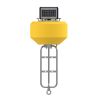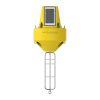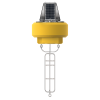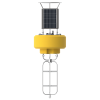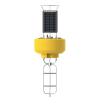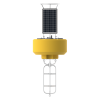SeaView Systems SVS-603HR Wave Sensor
Features
- Plug-and-play interface with the full line of NexSens XB-Series & CB-Series data buoys
- Sophisticated onboard electronics provide near-real-time wave statistics
- On-board data logger capable of logging as much as twenty years of wave data
- Expedited repair and warranty service
- Lifetime technical support
- More
The SeaView Systems SVS-603HR represents a new generation in accuracy and completeness for wave sensing electronics whose features include:
- Low power consumption; fits the smallest power budget
- Small environmental footprint; sold packaged or as bare PCB
- Sensors account for 3-D motion, rotation and compass heading in all dimensions to cover nine degrees of freedom
- Onboard electronics provide near-real-time wave statistics
- Variable sample set size (256, 512, 1024, 2048 or 4096)
- On-board temperature compensation
- On-board data logger capable of logging as much as twenty years of wave data, depending on desired outputs
- Easy configuration to match exact sensing rate and output requirements
- Readily interfaced with transmitter using NMEA or other configurable data output
- Sampling rates from 1 to 8Hz (user configurable)
The SVS-603HR can be used to replace existing sensors, to upgrade existing buoys, or to add wave sensing capabilities to even the most compact buoys. Among the wave data that are available as outputs from the sensor are:
- Significant wave height in meters (Hs)
- Wave period in seconds
- Wave direction in degrees from north
- North, east and up displacement time series
- First-5 Fourier wave coefficients
- Maximum wave height (Hmax)
- Wave period at Hmax
- Wave energy
- Spectrum (raw or processed)
- Heading in degrees
- Custom outputs as required
In The News
Sargassum Surge: How Seaweed is Transforming our Oceans and Coastal Ecosystems
Until recently, Sargassum –a free-floating seaweed–was distributed throughout the Sargasso Sea , the north Caribbean Sea, and the Gulf of Mexico. But in the space of a decade, this seaweed has, as one scientist remarks , “Gone from a nonfactor to the source of a terrible crisis.” Driven by climate change, anomalous North Atlantic Oscillation in 2009-2010 and a glut of anthropogenic pollutants, sargassum has proliferated. Seasonally recurrent mats as deep as 7m now bloom in the “Great Atlantic Sargassum Belt” (GASB), which covers areas of the Atlantic from West Africa to the Caribbean Sea and Gulf of Mexico. Every year, millions of tons wash up along the shores of more than 30 countries . Dr.
Read MoreGreat Lakes Research Center: Designing Targeted Monitoring Solutions
According to the National Oceanic and Atmospheric Administration ( NOAA ), the Great Lakes have more miles of coastline than the contiguous Atlantic and Pacific coasts combined and contain 20 percent of the world's freshwater, making it a critical region to protect and conserve. Continuous monitoring and data-informed resource management are key components of managing waters in the region. Hayden Henderson, a research engineer with the Great Lakes Research Center (GLRC), designs and deploys monitoring platforms throughout the Great Lakes. With a background in environmental engineering, Henderson enjoyed the challenge of creating systems and making them work to obtain difficult, remote measurements.
Read MoreMonitoring Meadowbrook Creek: Real-Time Data Collection in an Urban Creek
Meadowbrook Creek in Syracuse, New York, has been monitored by Syracuse University (SU) faculty and students for over a decade. Originally established by Dr. Laura Lautz in 2012, the early years of the program focused on collecting grab water samples for laboratory analysis and evaluating the impact of urban land use, human activities, and natural processes on water resources. Tao Wen , an Assistant Professor in SU’s Department of Earth and Environmental Sciences, took over the program in 2020 and upgraded the existing systems to include 4G modems that allowed for real-time data viewing. [caption id="attachment_39339" align="alignnone" width="940"] An overview of the Fellows Ave monitoring station along Meadowbrook Creek.
Read More









